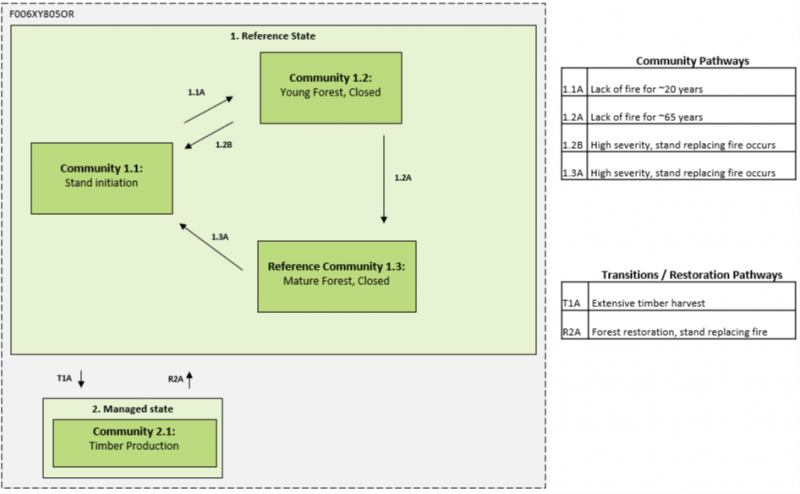
Natural Resources
Conservation Service
Ecological site F003XD806OR
Frigid Udic Maritime Mountain Slopes 60-90 PZ
Last updated: 5/10/2024
Accessed: 12/22/2024
General information
Provisional. A provisional ecological site description has undergone quality control and quality assurance review. It contains a working state and transition model and enough information to identify the ecological site.
MLRA notes
Major Land Resource Area (MLRA): 003X–Olympic and Cascade Mountains
Major Land Resource Area (MLRA): 003X–Olympic and Cascade Mountains
This area includes the west slope and parts of the east slope of the Cascades Mountains in Washington and Oregon. The Olympic Mountains in Washington State are also included. These mountains are part of a volcanic arc located at a convergent plate boundary. Volcanic rocks predominate but metamorphic and sedimentary rocks occur in the North Cascades and Olympic Mountains. Topography is generally dissected and steep, but some areas consist of constructional volcanic platforms and isolated stratovolcanoes. Elevation is usually 500 to 6000 feet but reaches to 14,410 ft at the summit of Mount Rainier. Many areas hosted alpine glaciers or ice sheets during the Pleistocene, and a few remain today.
Climate becomes cooler and moister with increasing elevation and latitude. Low elevations experience a long growing season and mild temperatures. High elevations can accumulate snowpack lasting into summer and frost may occur in any month. Average annual precipitation ranges from 60 to 180 inches in most areas. Most precipitation falls during the fall, winter, and spring during low-intensity frontal storms. Summers are relatively dry. Average annual temperature is 27 to 50 degrees F. The frost-free period is 10 to 180 days.
Classification relationships
Forested Plant Associations of the Oregon East Cascades (Simpson 2007)
Plant association group – Western Hemlock, Wet
Plant Associations of the Commercial Forest of the Warm Springs Indian Reservation (Marsh 1987)
Western Hemlock / Rhododendron macrophyllum
Western Hemlock / Vine Maple
Landfire biophysical settings model (Landfire 2007)
0711740 North Pacific Dry-Mesic Silver Fir-Western Hemlock-Douglas-fir Forest
Ecological site concept
This site encompasses a group of forest communities encompassed by the modified maritime influenced, western hemlock (Tsuga heterophylla) zone at middle elevations on the east slope of the Oregon Cascades. In reference condition, this site supports a forest canopy dominated by western hemlock, Douglas-fir (Pseudotsuga menziesii), with noble fir (Abies procera) and understory reproduction of Douglas fir, western hemlock and grand fir common. Plant community diversity is high with many wet site indicator species present such as pacific rhododendron (Rhododendron macrophyllum), prince’s pine (Chimaphila umbellata), bigleaf huckleberry (Vaccinium membranaceum), Oregon boxwood (Paxistima myrsinites), bride’s bonnet (Clintonia uniflora), pacific trillium (Trillium ovatum) and beargrass (Xerophyllum tenax). In comparison to mixed conifer sites receiving less precipitation, the maritime influence of this site results in a udic rather than xeric soil moisture regime with greater available moisture during the summer season. In comparison to mixed conifer sites dominated by grand fir, protected slope aspects and higher precipitation facilitate higher effective moisture conditions beneficial to western hemlock, and further prolong fire return intervals. Unlike forest sites found further west in the Oregon cascades, the maritime influence of this site is weakened by the rainshadow effect of the Cascade crest, resulting in lower mean annual precipitation and larger temperature variations in winter. In comparison to sites situated at higher elevations toward the Cascade crest, where mountain hemlock (Tsuga mertensiana) or pacific silver fir (Abies amabilis) may become important canopy dominates overtime, this site has a frigid rather than cryic soil temperature.. This condition favors the competitive dominance of western hemlock which requires warmer temperatures and shallower snowpacks in order to persist.
This is a provisional ecological site that groups characteristics at a broad scale with little to no field verification and is subject to extensive review and revision before final approval. All data herein was developed using existing information and literature and should be considered provisional and contingent upon field validation prior to use in conservation planning
Associated sites
| F003XD805OR |
Frigid Udic Maritime Mountain Slopes 40-60 PZ Occupying landforms downslope or landscape positions with lower precipitation and/or soil moisture accumulation and retention. |
|---|
Similar sites
| F003XD805OR |
Frigid Udic Maritime Mountain Slopes 40-60 PZ Lower precipitation, western hemlock less common |
|---|
Table 1. Dominant plant species
| Tree |
(1) Tsuga heterophylla |
|---|---|
| Shrub |
(1) Acer circinatum |
| Herbaceous |
Not specified |
Click on box and path labels to scroll to the respective text.
Ecosystem states
| T1A | - | Extensive timber harvest |
|---|---|---|
| R2A | - | Forest restoration, stand replacing fire |
State 1 submodel, plant communities
| P1.1A | - | Lack of fire for ~10 - 40 years |
|---|---|---|
| P1.2B | - | High severity, stand replacing fire occurs |
| P1.2A | - | Lack of fire for ~80 years |
| P1.3A | - | High severity, stand replacing fire occurs |
